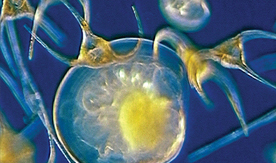
Two UMaine Researchers Team with UC Berkeley Professor to Study Effects of Turbulence on Cells’ Sinking Rate, Trajectory, Distribution
Two University of Maine researchers are teaming up with a University of California-Berkeley professor to study the sinking rate and trajectories of phytoplankton in relation to particle shape and water turbulence. Phytoplankton provide the food supply at the base of the marine food web and help maintain the health of the atmosphere by absorbing and sequestering carbon dioxide and producing oxygen.
Lee Karp-Boss, a marine scientist and associate professor in the UMaine School of Marine Sciences, is a principal investigator of the project along with Evan Variano, a researcher in the Civil and Environmental Engineering Department at UC Berkeley. Pete Jumars, a UMaine professor of marine sciences and oceanography who is based at the Darling Marine Center (DMC), is a co-principal investigator of the study.
The National Science Foundation recently awarded $409,035 to the UMaine researchers and $315,869 to Variano for the three-year project that began in September 2013.
The purpose of the study, “Collaborative Research: Trajectories and spatial distributions of diatoms at dissipation scales of turbulence,” is to create a better understanding of how turbulence and particle shape affect the sinking velocity and paths of phytoplankton — specifically diatoms.
“Phytoplankton are microscopic organisms that are responsible for food production in the ocean and they account for about half of the oxygen that we breathe,” Karp-Boss says of the plant-like organisms.
Since phytoplankton are photosynthetic organisms and need light, they grow in the upper layer of the water column in oceans where turbulence caused by wind and waves prevails. Many phytoplankton types either can’t swim or have a limited swimming ability and are at the mercy of turbulence.
Turbulence mixes the cells, and if it’s strong and deep enough, transports them out of the illuminated upper layer of the ocean, or photic zone.
“That mixing affects the light fields they experience and that will ultimately determine rates of photosynthesis and production in the ocean,” Karp-Boss says.
Cell components have densities larger than seawater and therefore tend to sink. If phytoplankton sink too quickly, they exit the illuminated zone. Cells that settle away from the photic zone too deep serve as a food supply for organisms in the deep ocean. A fraction of these settling cells may get buried in sediments, effectively removing carbon dioxide from the atmosphere into the interior of the ocean, which explains the interest in the rate phytoplankton sinks, Jumars and Karp-Boss say.
Simple turbulence operates in all directions, carrying phytoplankton up and down. Scientists originally assumed a cell would move up or down at the same average speed in turbulence as it would in still water, but results have shown otherwise. Whether they sink or rise, more intense turbulence makes them move quicker. However, the methods used in the last decade give little insight into the mechanisms behind this acceleration, according to the UMaine researchers.
Studies conducted by atmospheric scientists have found key components of turbulence are the small eddies or vortices whose friction with the surrounding fluid — air or water — drains away the kinetic energy in turbulence. These eddies spin small water droplets out and make them more likely to collide, Jumars says.
Those findings don’t tell the whole story for phytoplankton because it doesn’t explain how buoyant particles are accelerated upward by turbulence. Testing this requires the ability to track individual phytoplankton cells in three dimensions as they move through eddies.
That’s why Karp-Boss and Jumars teamed with Variano, the UC Berkeley researcher, who with colleagues has developed a system that allows scientists to look at the trajectories of thousands of individual particles as they move.
Variano has developed a borescope with a double iris and video camera that gives the instrument binocular vision and captures the 3-D position of the cell.
“If you capture many quick snapshots, you can put all the frames together and see how this particle is moving in the water. If you calculate the distance and you know the time between frames, you can get velocity. You can also see whether their trajectories are straight or curved and how they settle or rise in the water. It gives us more information than just looking at mean sinking speeds of a population,” Karp-Boss says.
Most of the particles researchers have studied are spherical, while particles in nature are a variety of other shapes.
“Diatoms exhibit a striking morphological diversity, and we argue the shape of the particles will determine the trajectory and how fast they settle,” Karp-Boss says.
Karp-Boss and Jumars hope the project will also teach researchers more about the effects of turbulence on the distribution of phytoplankton cells. Whether the cells are randomly distributed or group together to form patches carries important implications to foraging strategies of grazers that feed on the cells. Turbulence is likely to play a role, but the underlying mechanisms are not yet fully understood.
The researchers will work together at both institutions throughout the project. The tanks design and construction, as well as characterization of the turbulent flows, will be done at UC Berkeley, while the experiments and analysis will be completed at UMaine.
In addition to their research, the PIs plan to hold a workshop at UMaine’s DMC in Walpole, Maine to bring together students from various departments who have similar interests in the dynamics of particles in flows.
“These types of questions are of interest to many STEM fields including engineering, physics, atmospheric science and — of course — oceanography. Learning from each other’s approaches, models and measurements can greatly enhance understanding of how particles and flows interact,” Karp-Boss says.
Convening students from different fields who deal with particles in turbulent flows at earlier stages of their careers will hopefully give them an opportunity to form lifelong interactions and collaborations across fields. Karp-Boss and Jumars met Variano at a similar conference devoted to this range of topics.
Contact: Elyse Kahl, 207.581.3747
